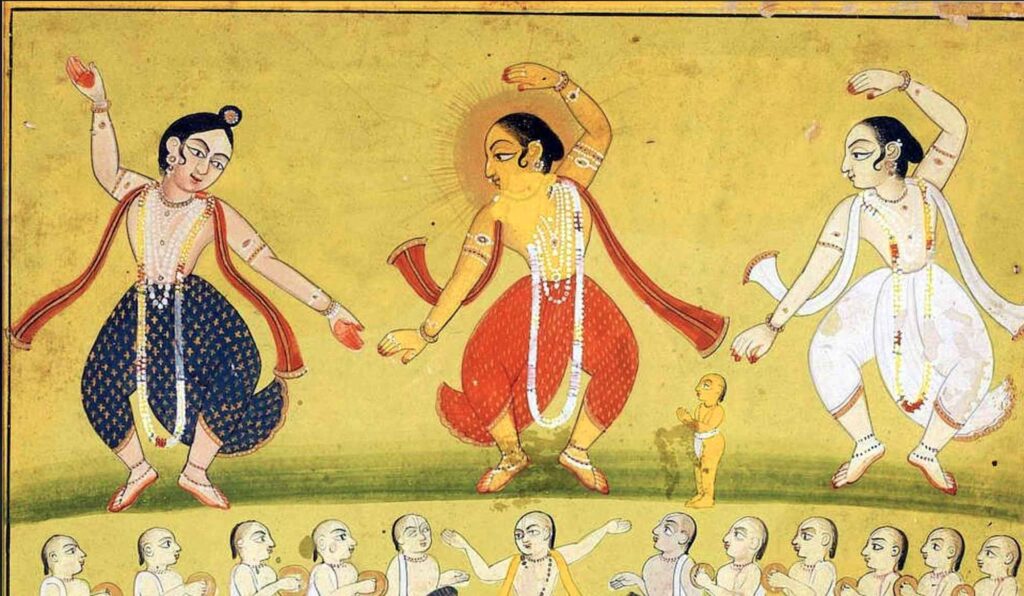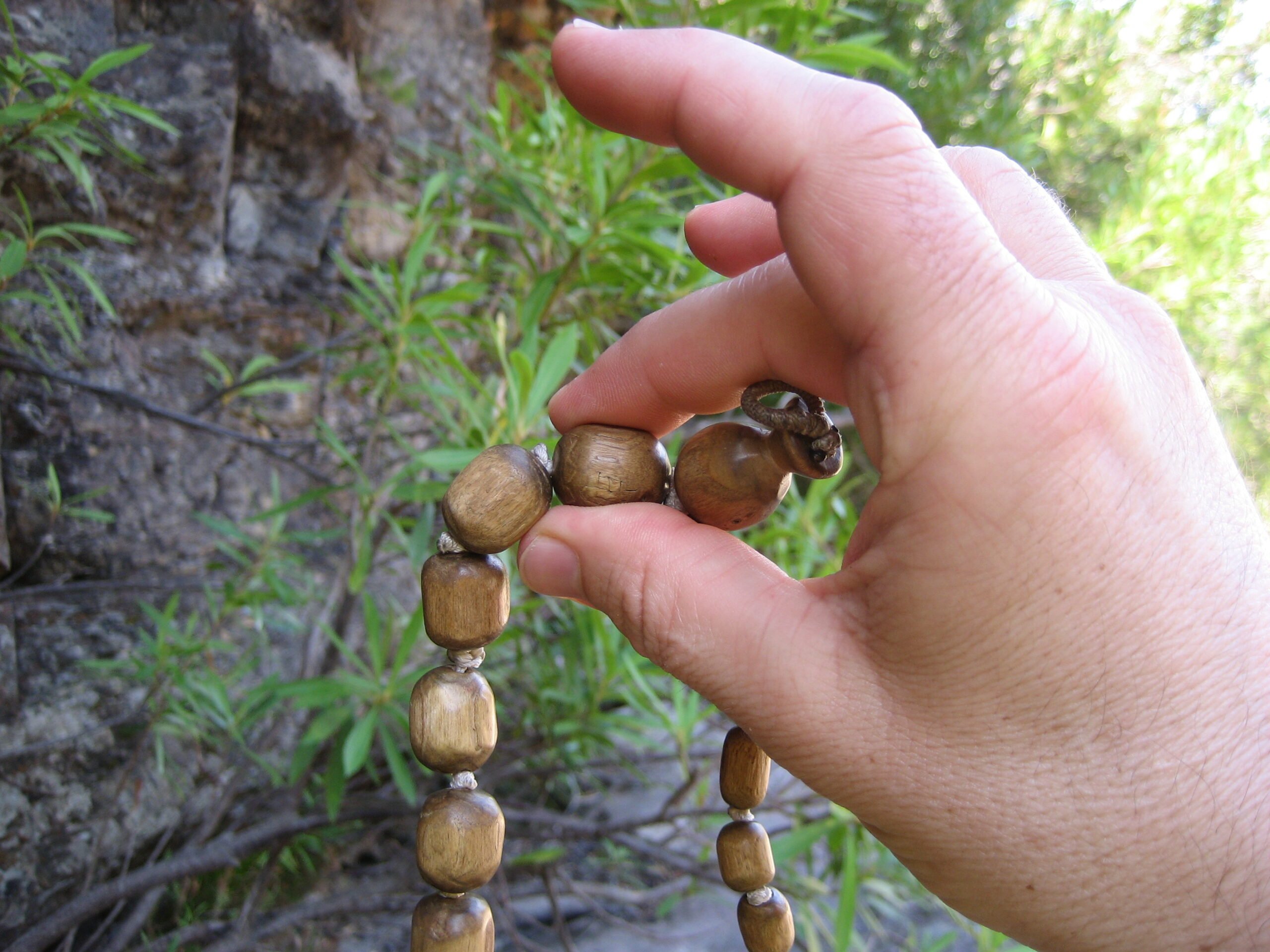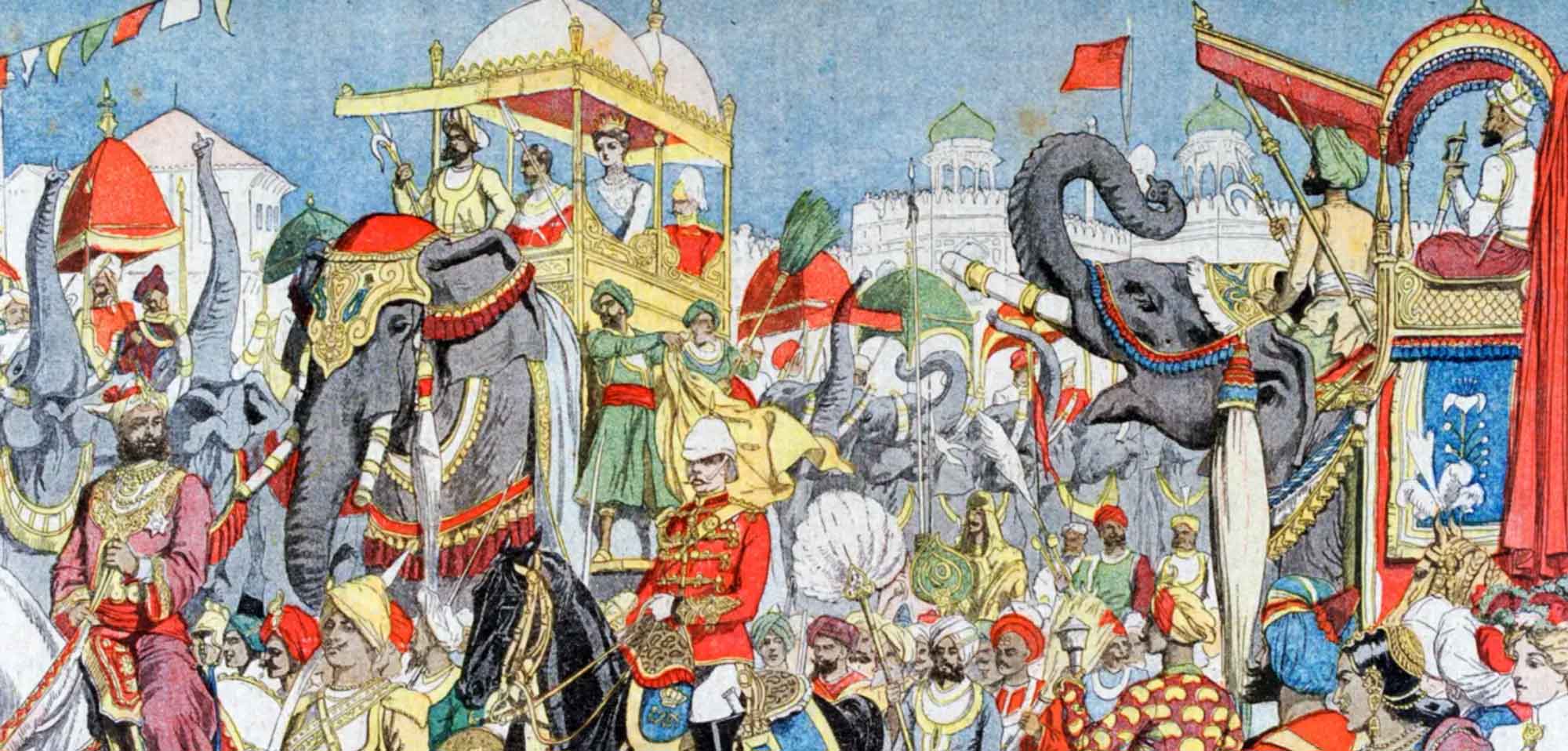Overview
Bhakti-siddhānta-viruddha o Rasābhāsa (Opposition to the Conclusions of Bhakti and Incompatible Rasa) was first published in Sajjana Toṣaṇi Vol.6. Issue 2. In this article Bhaktivinoda Ṭhākura writes about the various styles of rasa-kīrtana that orginated with Śrīnivāsa Ācārya, Narottama Dāsa Ṭhākura and Śyāmānanda Prabhu. He also discusses the so-called 'rasa-kīrtana' performed by professional kīrtaneers.
(translated by Swami B.V. Giri)
In Śrī Caitanya-caritāmṛta we see the following verse –
bhakti-siddhānta-viruddha, āra rasābhāsa
śunite nā haya prabhura cittera ullāsa
(“The Lord’s heart felt no joy in hearing rasābhāsa and anything opposed to the conclusions of bhakti.” – Caitanya-caritāmṛta, Madhya-līlā 10.113)
There are many substantial teachings in this verse. There are various schools of kīrtana nowadays. They refer to their songs as Manohārsāhī.* The tradition of their songs is that they first play the khol (mṛdaṅga). After that is the sura (melody). When the sura is set, they sing a song about Gauracandra. The rasa in Gauracandra’s song is the same rasa as the following pālā-gāna of kṛṣṇa-līlā.* At the time of the Gauracandra song, the singers, musicians and listeners stand up. When the song about Gaura is over, everyone sits down and sings and listens to the song about Kṛṣṇa. The pālās are full of songs by the previous mahājanas. The householder who performed the song arranges for garlands and sandalwood and first places then upon the mṛdaṅga, then offers them to the singers, then the musicians, and then the audience.
* Translators Note: The Bengali word pālā means ‘story.’ Thus, pālā-gāna, or pālā-kīrtana is a narrative about a particular līlā of Gaura or Kṛṣṇa.
Although the name of these songs are commonly called Manohārsāhī, research reveals that not all the songs are Manohārsāhī. The seeds of such songs in kīrtana were sown under Śrī Svarūpa Gosvāmī’s inspection of tattva of during the time of Śrīman Mahāprabhu. But at that time it was not very systematic. It was standardised during the time of Śrī Śrīnivāsa Ācārya. Śrīnivāsa Ācārya, Śrī Narottama Dāsa and Śrī Śyāmānanda – these three mahātmās resided for some time in Śrī Vṛndāvana as the disciples of Śrī Jīva Gosvāmī. They arranged the kīrtana system with the approval of Śrī Jīva Gosvāmī. The three of them were mahāmahopādhyās (the greatest scholars) in saṅgīta-śāstra (the śāstra dealing with music). All three were experts in the knowledge of the Kāloyati style of Delhi. The three of them were of one soul, one intention and devoted friends. However these three mahātmās were from different provinces. Śrīnivāsa Ācārya illuminated the province of Kātwā. His province belongs to the Manohārsāhī region. The style of songs that he introduced is called ‘Manohārsāhī.’ Śrī Narottama Dāsa was a resident of Kheturī-grāma in Garāṇhāṭi, or the region of Gaḍer Haṭa, of Rājsāhī district. The style of songs that he introduced is called ‘Garāṇhāṭi.’ Śrī Śyāmānanda was from Medinīpur district. The style of songs that he introduced is known as ‘Reṇetī.’ Śrī Jīva Gosvāmī gave Śrīnivāsa Ācārya the title of ‘Prabhu,’ Śrī Narottama Dāsa the title of ‘Thākura’ and Śrī Śyāmānanda the title of ‘Prabhu’ in order to encourage these gānācāryas (ācāryas of devotional songs). Śrī Jīva Gosvāmī was naturally supremely magnanimous and endowed with all transcendental qualities. Since Ācārya Prabhu was a brāhmaṇa, there was no objection to him receiving the title of ‘Prabhu.’ Śrī Narottama Dāsa was born in the kāyastha caste, and Śrī Śyāmānanda appeared in the sadagopa caste. Judging by their merits and greatness, it is only right that the Vaiṣṇava ācārya should have given them the titles of ‘Ṭhākura’ and ‘Prabhu.’
Encouraged by the approval of Śrī Jīva Gosvāmī, the three gītācāryas went to their respective provinces. These three mahātmās are ornaments of the land of Gauḍa. It seems that they were not as learned in Sanskrit as the Gosvāmīs. This is because no Sanskrit texts written by them can be found. They were learned in vraja-rasa bhajana, Vaiṣṇava siddhānta and expert in music. After Śrīman Mahāprabhu’s disappearance, the Vaiṣṇava world became devastated. Due to a lack of suitable recipients in the prabhu-vaṁśa (the lineage of Advaita and Nityānanda), and the introduction of various doctrines, the land of Gauḍa deteriorated without the authority of ācāryas. Due to the unique nature of Vircandra Prabhu, he could not bring all of Gauḍa-bhūmi under his control. There was a great disturbance amongst the sons of Śrīla Advaita. All of Mahāprabhu’s great associates began to disappear. At this opportunity, the propounders of evil doctrines such as the Bāula, Sahajiyā, Daraveśa, Saiṅ, etc. began to spread their propaganda in different places. There is some special faith in the Names of Śrī Caitanya and Nityānanda amongst the common folk. In order to do their own thing, they began to teach an evil path to these unfortunate jīvas. At that time, Śrī Jīva Gosvāmī was the only Vaiṣṇava ācārya. As a resident of Vraja, he was saddened by the miserable condition of Gauḍa-maṇḍala, so he established Śrīnivāsa Ācārya Prabhu, Śrī Narottama Dāsa Ṭhākura Mahāśaya and Śrī Śyāmānanda Prabhu as the religious reformers of Gauḍa-bhūmi, and they took all the books on siddhānta composed by the Lord’s associates to Gauḍa. By the will of Mahāprabhu, all these books were stolen. Without those books, these missionaries began to propagate pure Vaiṣṇava dharma on the strength of their own bhajana and system of songs.
At this time, their methods of singing were strongly propagated in their respective provinces. From time to time, the three ācāryas would gather at Kheturī, Viṣṇupur, Navagrāma, Gopīvallabhapur, etc., for installing Deities and other activities, and on those occasions they would discuss and plan things with each other. Due to their efforts, the pure dharma of the Vaiṣṇavas was revived and promulgated more than before. It is no exaggeration to say that these three preachers were the chief ornaments of Gauḍa-bhūmi.
The age of Kali is so terrible that it does not allow good deeds to last long. After the words of the three ācāryas and their follower, Śrī Govinda Dāsa and other mahājanas were neglected, the supreme dharma immediately became degraded again. In Gauḍa-bhūmi, discussions on pure bhakti became obsolete. Whether they were a Vaiṣṇava, a Śākta or a Karma-kāṇḍī, whoever they may be, the ācārya families began the work of preachers, as one does in Vaiṣṇava dharma. After much difficulty, Śrī Gaurāṅga, Nityānanda, Advaita and the pure Vaiṣṇava dharma introduced by Them gradually became remote. Meanwhile, during such turmoil amongst the ācāryas, again there was disturbance from the Bāulas, Sahajiyās etc. which gradually increased. The plight of Vaiṣṇava dharma is still evident today for these reasons.
Conclusions that are averse to Vaiṣṇavas can be observed everywhere in the world. Some follow māyāvāda as Vaiṣṇava dharma, some take that pure dharma and combine it with māyāvāda and karmavāda, and propagate a mutated form of Vaiṣṇava dharma. Then there are those who are innocent:
arcāyām eva haraye yaḥ pūjām śraddhayehate
na tad-bhakteṣu cānyeṣu sa bhaktaḥ prākṛtaḥ smṛtaḥ
(“One who faithfully and respectfully worships the Deity, but does respect other devotees or people in general, should be thought of as a neophyte devotee.” – Śrīmad Bhāgavatam 11.2.47)
According to this rule, such a person is situated as a kaniṣṭha Vaiṣṇava. There is a complete lack of intelligent pure Vaiṣṇavas. The condition of Gauḍa-maṇḍala nowadays is the same as the state of the jīvas when there is a lack of proper teachers. We do not have the scope to discuss here all the unfortunate events that have occurred. I will conclude this article by discussing some of the nuances that have arisen regarding the music introduced by the aforesaid three ācāryas.
Nowadays the Garāṇhāṭi kīrtana has almost become obsolete. Some persons know authentic Manohārsāhī kīrtana. There is no system of adding new words in authentic Manohārsāhī kīrtana. The words that the mahājanas have included in their songs make up the song itself. The Manohārsāhī songs are of a wonderful style. Repeating a verse two or four times evokes bhāva in the heart of the listener.
The words of the mahājanas are devoid of rasābhāsa (incompatible rasas) or conclusions that are in opposition to Vaiṣnavism. When persons do not know the concepts of rasa, or singers add their own words, it only creates trouble, and their words are rasābhāsa and opposed to siddhānta. Vaiṣṇava siddhānta is extremely deep. If pure Vaiṣṇava dharma is not discussed for many days in the company of sādhus, it is inevitable that opposing conclusions will ensue. Vaiṣṇava rasa is supremely esoteric. The rasa in mundane embellishments created by professors, and the rasa in the embellishments of transcendental Vaiṣṇavas are naturally different. Professional singers do not associate with real sādhus, nor do they understand Vaiṣṇava siddhānta properly. Therefore their words fall like a thunderbolts on a Vaiṣṇava’s ears.
Manohārsāhī songs are sung by very few people. Listening to their songs is an addition to one’s hearing. After the demise of Ustadjī Vaiṣṇava Dāsa, Śrī Advaita Dāsa of Kūliyā in Navadvīpa, Rāga-bhūṣaṇa Rasika-lāla Datta of Lākhuriyā, and Śrīyuta Varadā-prasāda Bāgjī Mahāśaya of Raṅgapur etc. still preserve the Manohārsāhī songs. Those who experience rasa even once after listening to their songs will no longer be interested in listening to the songs of those professional schools that are only interested in money. Nowadays professional business singers only sing the Reṇetī style for entertainment. In order to maintain some position amongst the Vaiṣṇavas, occasionally they may sing an authentic song. Amongst the professional singers, Veṇī Dāsa has some understanding of rasa. Everyone else is just a rasika by name only. They have no concept of rasa and what they speak is opposed to Vaiṣṇava siddhānta. There is plenty of rāgā, rāgiṇī, entertainment etc. in their songs, but not many Vaiṣṇavas are seen amongst their listeners. They add so many extra words to their songs, with the intention of satisfying the assembled women and idiots, that it is not known where the mahājana’s words are! The fools applaud, they give money, and that is why they are full of so much false-ego.
Again, there is no consideration about the time of a particular rasa. In Vaiṣṇava tattva, it is proper that the niśānta-līlā (pastimes at the end of the night) should be first. These dishonest entertainers sing about the niśānta-līlā at the end. This is opposed to Vaiṣṇava siddhānta. One other point within this which is terrible. The songs concerning Śrī Rādhā-Govinda’s śṛṅgāra–līlā, and listening to them, are our main worship and eternal bhajana. It is improper and offensive to sing about this bhajana-līlā to the whole public. Apana bhajana kathā, nā kahibe yathā tathā (‘Do not discuss your bhajana here and there’ – Śrīla Narottama Dāsa Thākura) – if one has faith in this ācārya’s words, then it makes it an aparādha to hear songs about rasa from the mouths of professional money-grabbing singers. At a previous gānotsava (song festival), a Vaiṣṇava mahātmā from Birbhum went to Śrī Kūliyā in Navadvīpa to listen to the music. There were songs about sambhoga-rasa (Rādhā and Kṛṣṇa’s union) being sung by all kinds of people. At that, he became appalled and left. Such offences by singers and listeners have become rampant nowadays.
Most people in the world are perverted, they love entertainment and they do whatever they want in the name of real bhajana. As long as this evil practice is not stopped, there will be no gravity to śṛṅgāra-rasa. O devotees! Do no listen to songs on rasa in assemblies of self-serving singers and listeners who find pleasure in mundanity. Leave that śrāddha assembly far behind!* Please take care that, in the assembly of Vaiṣṇavas, this method does not become present. Whenever those of different qualifications are in attendence, one should sing the Holy Name, prayers and songs about dāsya–rasa. Whenever pure rasika Vaiṣṇavas are present, one may listen to songs about rasa. And at the time of hearing such songs, one will eventually become eligible for one’s siddha–svarūpa (eternal spiritual form), experiencing the bhāva of bhajana. If this method of singing becomes obsolete, then so be it – that is also auspicious for the Vaiṣṇavas. The practice of singing songs on rasa here and there by those who are greedy for money and wish to enjoy their senses, gives Kali an occupation.
* Translators Note: A śrāddha assembly (śrāddha-sabhā) is a gathering to honour a dead relative.













